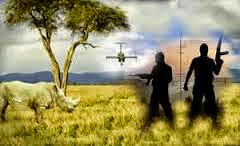Drones to the Rescue: Protecting wild life
Robots are catching poachers red-handed and giving biologists a cheap way to keep tabs on endangered animals.
Drones may have acquired a Terminator-like reputation as robotic agents of destruction, but when it comes to wildlife, they’re more like Arnold Schwarzenegger in Terminator 2: They’re here tp. 

Environmentalists are dispatching drones to help save dolphins at the cove in Taiji, Japan, and whales in the Faeroe Islands. In Costa Rica, meanwhile, conservationist commandos deploy an unmanned aerial vehicle (UAV) to intercept illegal fishing boats in a marine sanctuary in the latest episode of The Operatives, a new television series that airs Sundays at 10 p.m. ET/7 p.m. PT on Pivot TV, the television network owned by Participant Media, TakePart’s parent company. (A preview is above.)
The use of drones for conservation purposes is in its infancy, but the technology holds great promise for conducting censuses on wildlife, monitoring habitat, and performing other biological research. They are also well suited for use in combat zones and for fighting animal poaching and smuggling.
There’s another big bonus: Researchers don’t have to risk dying in small-plane crashes, the leading cause of death among wildlife biologists, according to a 2003 study in the Wildlife Society Bulletin.
In other words, drones can protect the lives of scientists as well as the animals they are studying.
But drones’ greatest strength is that they’re cheap: They can be operated for a fraction of the cost of conventional airplanes and helicopters, experts say.
“I’m very positive on the potential of these systems, or I wouldn’t have been working with them for as long as I have,” said Franklin Percival, a United States Geological Survey researcher who works with the University of Florida. “It’s extraordinarily exciting for a guy nearing retirement at 71.”
Percival avoids the word “drone,” preferring to call them UAVs. Drones, he said, are weaponized killing machines deployed by the military, whereas UAVs are armed only with
cameras

cameras

One organization spearheading the use of drones is Conservation Drones. Founded just two years ago, the group has helped hundreds of nonprofits, scientists, and government officials in more than a dozen countries.
Ecologists Lian Pin Koh and Serge Wich, the cofounders of Conservation Drones, first got the idea to use UAVs from Wich’s 20 years of studying orangutans in Indonesia. Koh had begun flying remote-controlled airplanes as a hobby and one day suggested that they attempt to send one of the toy planes aloft, with cameras attached, over a forested area of Sumatra.
The resulting photographs offered high enough resolutions to not only count orangutan nests but discern the kinds of leaves and twigs used to build them.
The total cost for one drone was less than $1,000, far below the cost of renting an airplane or a helicopter or sending researchers, their gear, and food into the forest on foot.
Today UAVs are helping conduct wildlife research around the world.
In Colorado, for example, researchers with the USGS found that drone surveys of migrating sandhill cranes were more accurate than ground studies, in part because the UAVs can fly over nesting areas without scaring the birds away.
Percival’s team from the University of Florida has flown drones to complete an accurate census of nesting waterfowl in that state, where 20,000 nests can be found in a two-mile stretch. The drones take thousands of GPS-stamped photos. The photos are patched together by computers and let researchers identify every single bird.
UAVs are not foolproof. “There’s a cost to working with things that are not fully baked yet," Percival said, the vehicles’ limited geographic range and their tendency to crash. "There are tons of limitations and drawbacks."
“Things can go wrong,” he said. “What goes up is going to come down, and it will land 100 percent of the time, but not just like you want it to.”
Drones can also be a hazard to aircraft, which has led the Federal Aviation Administration to strictly regulate their use.
UAVs can also disturb the wildlife they were meant to monitor and annoy visitors who come to see the animals, according to the National Park Service, which has banned the use of conservation drones at a number of parks and monuments in Utah and Arizona, including Zion National Park and the Grand Canyon. The NPS plans to extend the ban to some 84 million acres of public land and waterways.
Drones are not only helpful for conservation; they are ideal for filmmakers producing documentaries about conservation.
Louie Psihoyos, director of the Oscar-winning documentary The Cove, about the annual dolphin slaughter in Japan, used a drone to film one of the last scenes in the movie.
“We knew it would be dramatic to shoot the red blood and get a sense of scale of what the cove looked like,” he said. Even though he deployed a noisy, gas-powered vehicle (most drones today are electric and virtually silent), “the fishermen doing their dirty deeds never even noticed it.”
Psihoyos agreed that drones are not perfect. His company has lost three of its four UAVs in crashes.
“One outing on a drone can cost about 10 percent of renting an airplane and pilot,” he said, “as long as you don’t lose the whole thing in the water.”

takepart.com
takepart.com


Comments